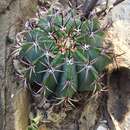pt-BR
nomes no trilho de navegação


Melocactus pachyacanthus ist eine Pflanzenart aus der Gattung Melocactus in der Familie der Kakteengewächse (Cactaceae). Das Artepitheton pachyacanthus bedeutet ‚mit dicken Stacheln‘.
Melocactus pachyacanthus wächst mit grünen bis graugrünen und manchmal glauken, niedergedrückt kugelförmigen bis verlängerten Körpern, die Wuchshöhen von 15 bis 30 Zentimetern und Durchmesser von bis 20 Zentimetern erreichen. Es sind 9 bis 11 niedrige Rippen vorhanden. Die kräftigen Dornen sind rötlich braun und grau überhaucht. Die 1 bis 3 Mitteldornen sind horizontal ausgespreizt und 2,8 bis 4,8 Zentimeter lang. Die 8 bis 9 geraden oder leicht gebogenen Randdornen erreichen Längen von 2,5 bis 4,9 Zentimetern. Das aus trüb rosaroten Borsten gebildete Cephalium wird bis 12 Zentimeter hoch und erreicht einen Durchmesser von 10 Zentimetern.
Die mehr oder weniger rosamagentafarbenen Blüten ragen kaum aus dem Cephalium heraus und öffnen sich manchmal nur teilweise. Sie sind 2,2 bis 2,5 Zentimeter lang und weisen Durchmesser von 7 bis 10 Millimeter auf. Die etwas abgeflachten Früchte sind weiß oder hellrosafarben und 1,6 bis 2 Zentimeter lang.
Melocactus pachyacanthus ist im brasilianischen Bundesstaat Bahia verbreitet.
Die Erstbeschreibung erfolgte 1976 durch Albert Frederik Hendrik Buining und Arnold J. Brederoo.[1]
Die Unterart Melocactus pachyacanthus subsp. viridis N.P.Taylor wird als eigenständige Art Melocactus neoviridescens Guiggi akzeptiert
Melocactus pachyacanthus wurde in der Roten Liste gefährdeter Arten der IUCN von 2002 als „Endangered (EN)“, d. h. stark gefährdet eingestuft. Dies galt 2002 auch für die Unterart Melocactus pachyacanthus subsp. pachyacanthus. Melocactus pachyacanthus subsp. viridis galt hingegen als „Critically Endangered (CR)“, d. h. vom Aussterben bedroht. Bei der Aktualisierung 2010 wurden die Unterarten nicht neu bewertet und aus der roten Liste entfernt. Die Art gilt im Jahr 2013 als „Vulnerable (VU)“, d. h. gefährdet.[2]
Melocactus pachyacanthus ist eine Pflanzenart aus der Gattung Melocactus in der Familie der Kakteengewächse (Cactaceae). Das Artepitheton pachyacanthus bedeutet ‚mit dicken Stacheln‘.
Melocactus pachyacanthus is a species of cactus. It is endemic to Brazil, where it is known only from two locations in Bahia. Its populations are fragmented and it is vulnerable to habitat degradation.[1]
Melocactus pachyacanthus is a species of cactus. It is endemic to Brazil, where it is known only from two locations in Bahia. Its populations are fragmented and it is vulnerable to habitat degradation.
Melocactus pachyacanthus es una especie de planta fanerógama de la familia Cactaceae. Es endémica del sudeste de Bahia en Brasil donde se encuentra en las áreas rocosas y desiertos. Está tratada en peligro de extinción por pérdida de hábitat.
Melocactus pachyacanthus es de color verde a gris-verde y algunas veces glauco, con el tallo deprimido esférico a alargado que llegan a alcanzar un tamaño de 15 a 30 centímetros de altura y un diámetro de 20 centímetros. Tiene de 9 a 11 costillas con areolas de afiladas espinas de color rojizo marrón y gris. Las 1 a 3 espinas centrales se extienden horizontalmente y miden de 2,8 a 4,8 centímetros. Los 8-9 espinas radiales son rectas o ligeramente curvas y alcanzan una longitud 2,5 a 4,9 centímetros. El cefalio formado de cerdas de color rosa opaco crece hasta 12 centímetros y alcanza un diámetro de 10 centímetros.
Las flores son de color magenta o rosa y abiertas apenas sobresalen del cefalio, midiendo de 2,2 a 2,5 centímetros de longitud y de 7 a 10 milímetros de diámetro. Los frutos son ligeramente aplanados y de color rosa o de color claro y de 1,6 a 2 centímetros de largo.
Melocactus pachyacanthus fue descrita por Buining & Brederoo y publicado en Kakteen und andere Sukkulenten 27(1): 1. 1975.[2][3][4]
Melocactus pachyacanthus es una especie de planta fanerógama de la familia Cactaceae. Es endémica del sudeste de Bahia en Brasil donde se encuentra en las áreas rocosas y desiertos. Está tratada en peligro de extinción por pérdida de hábitat.
Melocactus intortus é uma espécie botânica de plantas da família das Cactaceae. É endêmica do sudeste do estado da Bahia, no Brasil, sendo encontrada em regiões rochosas e áridas. É uma espécie que corre risco de extinção.
É uma planta perene carnuda e globosa armados com espinhos, de cor verde e com as flores de cor rosa e púrpura.
Melocactus intortus é uma espécie botânica de plantas da família das Cactaceae. É endêmica do sudeste do estado da Bahia, no Brasil, sendo encontrada em regiões rochosas e áridas. É uma espécie que corre risco de extinção.
É uma planta perene carnuda e globosa armados com espinhos, de cor verde e com as flores de cor rosa e púrpura.
Melocactus pachyacanthus là một loài thực vật thuộc họ Cactaceae. Đây là loài đặc hữu của Brasil. Môi trường sống tự nhiên của chúng là vùng nhiều đá và sa mạc nóng. Chúng hiện đang bị đe dọa vì mất môi trường sống.
Phương tiện liên quan tới Melocactus pachyacanthus tại Wikimedia Commons
Melocactus pachyacanthus là một loài thực vật thuộc họ Cactaceae. Đây là loài đặc hữu của Brasil. Môi trường sống tự nhiên của chúng là vùng nhiều đá và sa mạc nóng. Chúng hiện đang bị đe dọa vì mất môi trường sống.